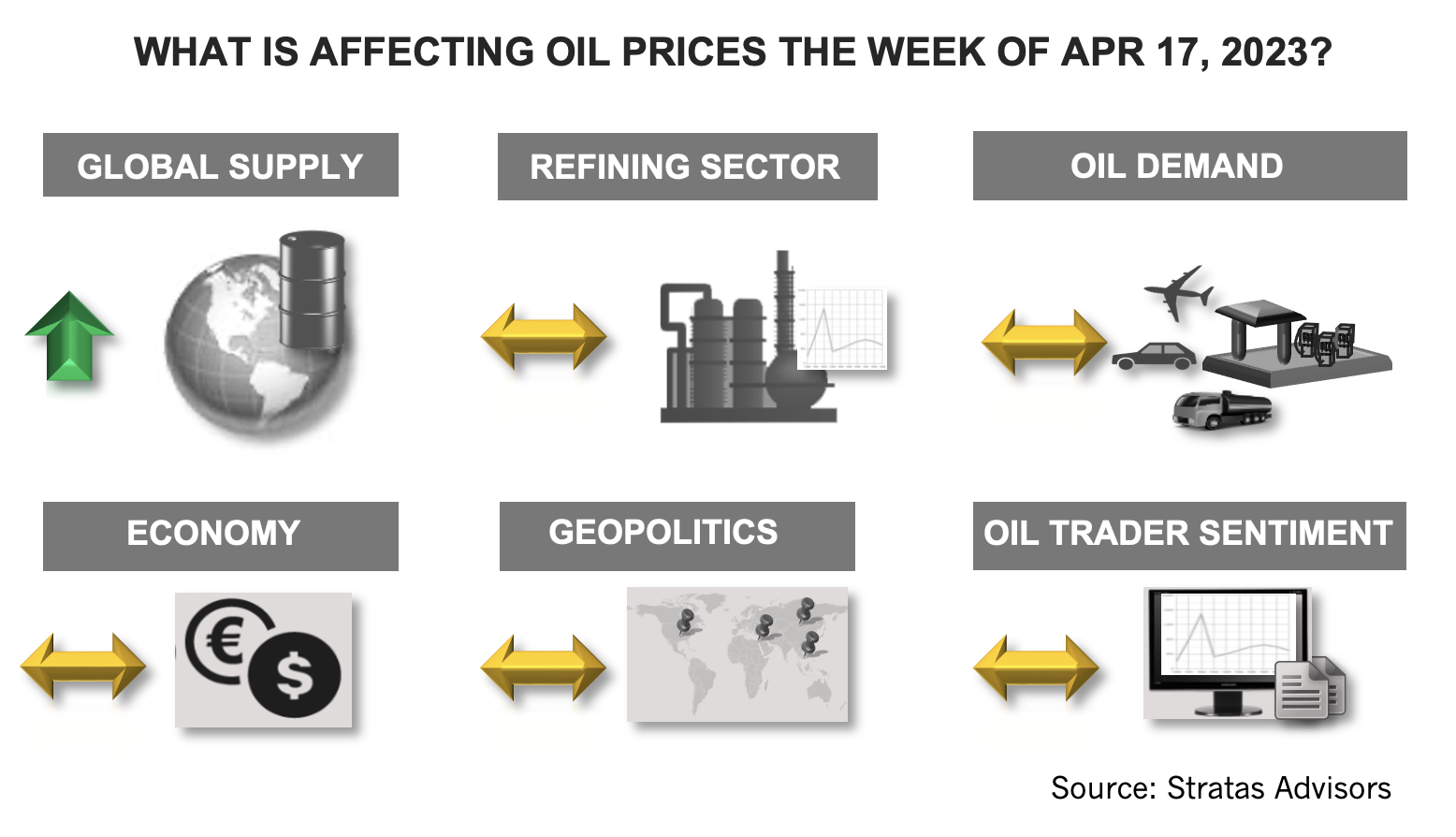
Stratas Advisors is remaining cautiously optimistic about oil prices. (Source: Shutterstock)
The price of Brent crude ended the week at $86.31 after closing the previous week at $85.12. The price of WTI ended the week at $82.52 after closing the previous week at $80.70.

As we expected, the pending production cuts pushed oil prices higher and past resistance levels for Brent ($86.00) and WTI ($82.00). Besides the pending production cuts announced by OPEC+, oil prices are getting some support from the weakness of the U.S. Dollar. Last week, the U.S. Dollar Index ended at 101.55 at from 102.09 of the previous week and is well below the 114.10 that was reached at the end of September 2022.
Prices might have also gotten a little bump from the U.S. Energy Secretary Jennifer Granholm indicating last week that the Biden Administration plans to refill the U.S. Strategic Petroleum Reserve (SPR) yet this year. We remain highly skeptical of this happening, especially since the possibility was raised with the caveat that such purchases will only occur if advantageous for U.S. taxpayers. Additionally, inventories at the SPR are now declining again to meet the budget requirement to sell another 26 million barrels.
As we highlighted last week, for the rest of the year, we are forecasting that the price of Brent crude oil will average $93.13, which compares to our previous forecast of $88.57. We also highlighted that there is more downside risk than upside risk to the forecast.
China had a significant increase in crude imports with March imports 22.5% higher than during March of last year. For the first quarter, China’s crude imports were 6.7% higher than that of the previous year. However, some of the increase in crude imports is stemming from China exporting more refined products. During March, Chinas’ exports increased by 35.1% in comparison to March of last year, which translated to an increase of more than 300,000 bbl/d (around 1.4 million tonnes). Additionally, China’s economy is still growing moderately since the removal of the zero-COVID policies. While the March PMI for services increased to 57.80 from 55.00 in February, the manufacturing PMI decreased from 51.60 to 50.00. Consequently, the composite PMI only increased to 54.50 from 54.20.
RELATED
China’s COVID Pivot Boosts Oil, Gas, LNG Demand
Last week, there were some additional signs of inflation slowing down in the U.S. The consumer price index (CPI) increased last month by 0.1% and by 5% on an annual basis. The increase was the smallest since June 2021 and was driven by the reduction in energy prices and by the first decrease in food prices since September 2020. The cost of shelter continues to be a major source of inflation in that it represents about 33% of the CPI. The cost of shelter increased by 0.6%, and while it was the smallest increase since November, the increase translates into 8.2% on an annual basis.
While the rate of inflation is slowing down, it appears to be happening, in conjunction with increasing stress on the economy:
- Retail sales decreased by 1% in March after sales decreased by 0.2% in February
- Real wages have been falling for 24 consecutive months
- Consumer debt is at record levels with record-level interest rates
Additionally, as we highlighted last week, the U.S. job market is cooling. The jobs report for March indicated that the U.S. economy added 236,000, which is the lowest level of monthly increases since December 2020. Additionally, the number of job openings dropped to 9.93 million, which is the first sub-10 million reading in nearly a decade. The number of layoffs increased to nearly 90,000, which is a 15% increase in comparison to February. Continuing jobless claims reached 1.823 million, which is the highest level since December 2021. Another sign of the U.S. economy slowing down is that according to the Association of American Railroads (AAR) through the first quarter of this year, total North American carload and intermodal traffic is 3.9% less in comparison with last year. Despite the weakness in the U.S. economy, we are expecting that the Federal Reserve will increase interest rates by another 0.25% at its next meeting in early May, in part, because core inflation (stripping our food and energy) continues to be elevated with the monthly increase of 0.4% in March and 5.6% on an annual basis.
For a complete forecast of refined products and prices, please refer to our Short-term Outlook.
About the Author: John E. Paise, president of Stratas Advisors, is responsible for managing the research and consulting business worldwide. Prior to joining Stratas Advisors, Paisie was a partner with PFC Energy, a strategic consultancy based in Washington, D.C., where he led a global practice focused on helping clients (including IOCs, NOC, independent oil companies and governments) to understand the future market environment and competitive landscape, set an appropriate strategic direction and implement strategic initiatives. He worked more than eight years with IBM Consulting (formerly PriceWaterhouseCoopers, PwC Consulting) as an associate partner in the strategic change practice focused on the energy sector while residing in Houston, Singapore, Beijing and London.
Recommended Reading
Diamondback to Sell $2.2B in Shares Held by Endeavor Stockholders
2024-09-20 - Diamondback Energy, which closed its $26 billion merger with Endeavor Energy Resources on Sept. 13, said the gross proceeds from the share’s sale will be approximately $2.2 billion.
Optimizing Direct Air Capture Similar to Recovering Spilled Wine
2024-09-20 - Direct air capture technologies are technically and financially challenging, but efforts are underway to change that.
Analyst: Is Jerry Jones Making a Run to Take Comstock Private?
2024-09-20 - After buying more than 13.4 million Comstock shares in August, analysts wonder if Dallas Cowboys owner Jerry Jones might split the tackles and run downhill toward a go-private buyout of the Haynesville Shale gas producer.
Matador Offers $750 Million in Senior Notes Following Ameredev Deal
2024-09-20 - Matador Resources will offer $750 million in senior notes following the close of its $1.83 billion Ameredev II acquisition.
Aethon, Murphy Refinance Debt as Fed Slashes Interest Rates
2024-09-20 - The E&Ps expect to issue new notes toward redeeming a combined $1.6 billion of existing debt, while the debt-pricing guide—the Fed funds rate—was cut on Sept. 18 from 5.5% to 5%.
Comments
Add new comment
This conversation is moderated according to Hart Energy community rules. Please read the rules before joining the discussion. If you’re experiencing any technical problems, please contact our customer care team.





